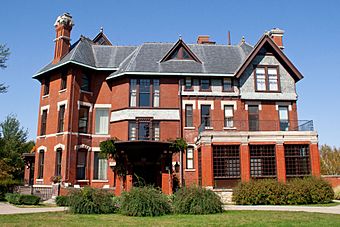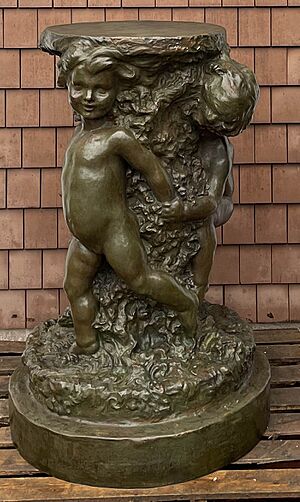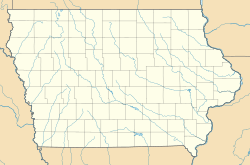Brucemore facts for kids
Quick facts for kids |
|
|
T. M. Sinclair Mansion
|
|

Front entrance of Brucemore; originally the back of the house
|
|
| Location | 2160 Linden Drive, SE Cedar Rapids, Iowa |
|---|---|
| Area | 26 acres |
| Built | 1884–1886 |
| Architect | Maximillian Allardt, Henry Josselyn and Eugene Taylor. Additions by Howard Van Doren Shaw and Grant Wood |
| Architectural style | Queen Anne |
| NRHP reference No. | 76000780 a |
| Added to NRHP | December 12, 1976 |
Brucemore is a beautiful estate in Cedar Rapids, Iowa. It's like a big park, covering about 26 acres (10.5 hectares). On this land, you'll find a grand mansion built in the Queen Anne style. There are also lovely gardens, including a special one for children, a pond, an orchard, and a wooded area.
The mansion was built between 1884 and 1886. Three important families have lived here, making Brucemore a center for culture and art. Its name, Brucemore, reminds us of the Scottish moors, which were part of the second owner's family history. Brucemore is the only National Trust Historic Site in Iowa. It is also listed on the National Register of Historic Places as the T.M. Sinclair Mansion. The mansion has three floors and 21 rooms. It has a steep roof, five chimneys, and several turrets, which are small towers.
Contents
Exploring Brucemore's Past
Brucemore's story is about three wealthy families. They were industrialists, business owners, and people who helped their community. The men made large fortunes: Thomas Sinclair in meatpacking, George Bruce Douglas in starch processing, and Howard Hall in manufacturing. But the women of Brucemore are truly at the heart of its history. Caroline Sinclair built the mansion, Irene Douglas turned it into a country estate, and Margaret Hall later gave it to the National Trust.
The Sinclair Family (1886–1906)
In 1871, Thomas McElderry and Caroline Soutter Sinclair moved to Cedar Rapids from New York City. Thomas started a meatpacking business called T.M. Sinclair & Co. This company grew to be the biggest business in the city. Sadly, Thomas died in an accident at his plant in 1881. Caroline was left to raise their six children, the youngest of whom was only six months old.
In 1884, Caroline Sinclair bought land outside the city limits. She began building a large Queen Anne-style mansion. She named her new home "Fairhome."
Maximillian Allardt, an architect from Indianapolis, designed the house. When his daughter became ill, Allardt left the project. Henry Josselyn and Eugene Taylor then finished the work. The original plans for the house included a large main hall, eight bathrooms, nine bedrooms, and 14 fireplaces. It also had a grand staircase. Caroline added a conservatory, which is like a greenhouse, to the south side of the house.
The home was finished in 1886 and cost $55,000. Local newspapers called it "the grandest house west of Chicago." In 1906, after all her children had grown up, Caroline traded homes with George Bruce Douglas. She moved to a different house in Cedar Rapids.
The Douglas Family (1906–1937)

George Bruce Douglas was a partner in his father's business, the Quaker Oats Company. George moved into the home with his wife, Irene, and their daughters, Margaret and Ellen. They renamed the estate "Brucemore." Irene was a talented amateur bookbinder. She bound many of the books now found in the house's library. This includes 40 volumes of William Shakespeare's plays and poems.
Under George's guidance, the property grew to about 33 acres (13.4 hectares). Several new buildings were added. These included a guesthouse, a greenhouse, a carriage house, a squash court, and servants' quarters. George also moved the main entrance to the south side of the house. The inside of the mansion was also updated. Exposed ceiling beams and butternut wood paneling were added to the great hall. This expansion cost over $30,000. Howard Van Doren Shaw, a famous architect from Chicago, designed these changes.
In the 1920s, a large mural was added. It showed the story of "The Ring of the Nibelung" from Richard Wagner. A large 714-pipe organ was installed on the third floor. In 1925, the artist Grant Wood designed a sleeping porch for the house. A swimming pool was added in 1927. In 1929, Irene started a big redecoration project. She worked with Elizabeth Eleanor D'Arcy Gaw, who chose bird-themed wallpaper for the third floor.
George died in 1923. Fourteen years later, Irene passed away. She left the home to their oldest daughter, Margaret.
The Hall Family (1937–1981)
Margaret Douglas married Howard Hall in 1924. The couple lived on the Brucemore grounds in the Garden House. They stayed there until Margaret's mother passed away. While living there, they sold off some of the property. This reduced the estate to its current 26 acres (10.5 hectares). They also enclosed the western porch. Large picture windows were added to the master bedroom, the library, and the dining room.
The Halls made some very unique additions to the house. They created two fun recreation rooms in the basement. One was called "The Tahitian Room." It was designed to look like a tropical island. It even had a fake hut roof and a switch that could make artificial rain! The other room was the "Grizzly Bar." This room was decorated like a Wild West or Alaskan saloon.
The Halls had many pets on the property. These included two German shepherds, a monkey, and several birds. Their most famous pets were three lions, all named Leo. One of these Leos was related to Jackie, the lion that roars at the start of MGM movies. One of the lions and 20 dogs are buried in the pet cemetery near the gardens.
When Margaret died in 1981, she gave Brucemore to the National Trust for Historic Preservation.
Brucemore Today: A Community Hub
Today, Brucemore is a lively center for culture, charity, and education. About 40,000 people visit each year. They come for many different events. These include festivals, concerts, tours, garden programs, and activities for children and families. Brucemore also hosts outdoor theater performances. It continues to be an important part of the Cedar Rapids community.




